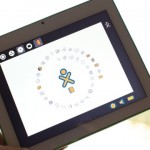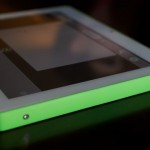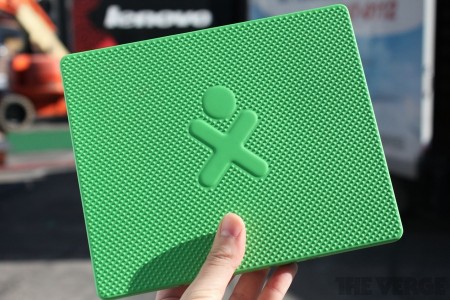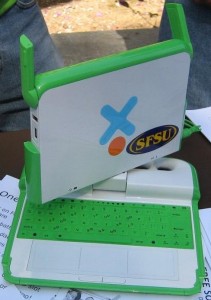Sandra Barragán posted a photoset from Rodrigo’s visit to Colombia yesterday.
And the Fargo team develops some game-like projects around Physics and Etoys.

Sandra Barragán posted a photoset from Rodrigo’s visit to Colombia yesterday.
And the Fargo team develops some game-like projects around Physics and Etoys.
Brian Barrett at Gizmodo, which has followed the XO-3 development quite closely, published a detailed hands-on review of the first prototype from CES.
It is a lovely review, well worth the read. His crew also took some fantastic photographs of the tablet in action:
 |
 |
 |
 |
 |
 |
Joanna Stern, who has reviewed many OLPC models in the past, takes an in-depth look at the XO-3 prototype at CES, in a detailed review for The Verge. In addition to an excellent writeup, she interviews Ed McNierney while exploring the laptop in person, in what looks like Max Headroom’s office. They talk about everything from hardware and power to software and deployment.
They also took the best set of photos of the XO-3 and solar-cover to date!


As foreshadowed 18 months ago, an XO-3 prototype is debuting at CES this weekend, and will be shown off next week at the Marvell booth. Here is a sneak peek at what it looks like:

If you are heading to CES, you can stop by and see it yourself! Ping Giulia to set up an appointment, or drop by the Marvell booth. Charbax of olpc.tv will be on site as always, recording some video and interviews.
The XO-3 will sport a 1024×768 Pixel Qi screen, half-gig of RAM, and a Marvell Armada PXA618 chip. Some of the soft cover designs proposed so far include a built-in solar panel. More updates coming over the next week; for now, here is our CES press release.
The XO-3 is still planned to enter production at the end of this year.

For four years, OLPC has had fruitful collaboration with the indefatigable Sameer Verma and others at SFSU, on hardware, Sugar activity design, and community building. Now at last we have a formal MOU between the University and OLPC[A]. This may be just the first of many MOUs with universities in the US, as we develop a network of supporting organizations working with OLPC on international projects.

Sameer and his students and colleagues have already worked with grassroots OLPC projects in Tuva, India, Armenia, Jamaica, and North Africa. Thanks to you all for your support and great ideas so far; we look forward to working more actively together, and perhaps drawing in new departments as well 😉
There’s a lovely and unflinching personal recollection by Sameer of the development of his XO addiction, on SFSU’s opensource blog. A few highlights:
OLPC came into my professional [and personal] life in July 2007 when I signed up for the Developers Program and got an OLPC XO-1 B2 machine. How excited was I? I slept with it under my pillow. Seriously.
The hype and novelty factor diminished in six months and the question arose: “Why bother spending a Saturday for this?” Then came the answer in the form of actual projects… work, not just advocacy. We started with four projects and now have a list of fourteen.
You can read the text of the MOU as well.
Also: The first Marvell ARMADA-powered XO 1.75 laptop will begin shipping in March to school children in Uruguay and Nicaragua
SANTA CLARA, Calif. / LAS VEGAS (Jan. 9, 2012) – Marvell Semiconductor (Nasdaq: MRVL), a worldwide leader in integrated silicon solutions, and One Laptop per Child, a non-profit organization dedicated to helping every child in the world gain access to a modern education, demonstrated a version of the much-anticipated XO 3.0 – a low-cost, low-power, rugged tablet computer designed for classrooms around the globe – at the 2012 International Consumer Electronics Show.
“We’re proud to introduce the XO 3.0 tablet, showcasing the design, durability and performance features that make it a natural successor for our current laptops, which have been distributed to more than 2.4 million children in 42 countries and in 25 languages,” said Ed McNierney, Chief Technology Officer of One Laptop per Child. “The XO 3.0 builds on many of the technology breakthroughs we made with the XO 1.75, including the use of the Marvell® ARMADA® PXA618 processor, resulting in a significant decrease in power consumption-a critical issue for students in the developing world.”
“Marvell is committed to improving education–and the human condition-around the world through innovative technology for Smartphones, tablets and a myriad of new cloud-delivered services. Partnering with One Laptop Per Child is one way we can deliver a revolution where it matters most-to benefit children in some of the poorest places on the planet,” said Tom Hayes, Vice President of Corporate Marketing at Marvell, and a member of the OLPC advisory board. “Marvell has been with One Laptop per Child from the start, and we’re doing whatever it takes to help the organization realize its mission of providing meaningful educational opportunities to the 500 million school-aged children around the world.”
Marvell and One Laptop per Child also announced today that the XO -1.75 laptop will begin shipping to customers in March 2012. Over 75,000 units of the XO 1.75 have already been ordered by OLPC projects in Uruguay and Nicaragua. Both models use the Marvell ARMADA PXA618 SOC processor, which doubles the performance of the earlier XO 1 while using only half the power. The XO 1.75 features a sunlight-readable screen, and all other features and design characteristics of the two previous versions of the XO laptop.
The XO 3.0 tablet will also feature the Avastar Wi-Fi system-on-chip.
It is also the only tablet that can be charged directly by solar panels, hand cranks and other alternative power sources
Other features include:
• Updated Pixel Qi sunlight-readable display
• Choice of Android or Linux operating systems
• Unique charging circuitry to support alternate power sources
• Choice of laptop covers, including one with built-in solar panel